|
 Since
we signed up with RMI, we booked our non climbing nights at Whittaker's
Bunkhouse in the small town of Ashford Washington. A mix up
in the reservation made months earlier made for a poor start with
RMI as they said they could only accommodate five of our nine for
our stay. Even a talk with Lou Whittaker himself couldn't change
anything so we were evicted and relocated to the Gateway Inn just
outside the park boundary. Sarah Whittaker, daughter-in-law - married
to Win, sought us out later to make amends. She restored our faith
in the customer orientation of RMI with her personal touch. Since
we signed up with RMI, we booked our non climbing nights at Whittaker's
Bunkhouse in the small town of Ashford Washington. A mix up
in the reservation made months earlier made for a poor start with
RMI as they said they could only accommodate five of our nine for
our stay. Even a talk with Lou Whittaker himself couldn't change
anything so we were evicted and relocated to the Gateway Inn just
outside the park boundary. Sarah Whittaker, daughter-in-law - married
to Win, sought us out later to make amends. She restored our faith
in the customer orientation of RMI with her personal touch.
All of our team finally arrived on Friday night, July 10 and
rendezvoused at the Gateway Inn. We had a nice dinner at the Copper
Creek restaurant complete with blackberry dressing, blackberry sauce
and blackberry pie for desert. The next day was climbing school and
then an early evening for the 2 day climb ahead.
Sunday we went back to RMI to meet our guides: Jeff
Justman (JJ), David
Conlan, and Corey
Raivio . This was to be JJ's 96th summit while Dave and Corey were
first year guides with less than 7 summits under their belts. They
were polite and professional with a great sense of humor as they walked
us through the routine. We loaded into a small bus with all our gear
for the forty minute ride to where the climb starts near the National
Park Service lodge at Paradise, Washington within the Mt. Rainier National
Park boundaries.
There are 4 legs to climbing Rainier: Paradise to camp Muir,
camp Muir to the summit, back to Muir and back to Paradise. The first
leg started by following an asphalt trail that helps non-climbers get
a little closer to nice views Rainier (on a clear day!). We were careful
to get in a single file line in order not to over run the tourists.
It had been rainy for the two previous days and none of our team had
actually seen the mountain so when the clouds broke from the summit,
we paused to take some pictures along with the Grand Ma's and kids
on the trail.
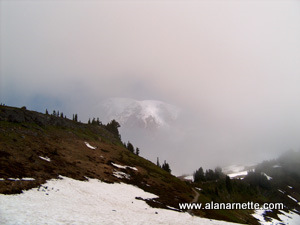
After passing pebble creek at 7,200' were stepped onto the
Muir Snowfield. This large snow slope leads to camp Muir at 10,040'.
There are some relatively steep sections along the way and a couple
of small (15') walls. Everyone did fine as we enjoyed the views. As
the clouds cleared, Rainier became huge in front of us and the sun
shown down bright and hot. We were dressed in light clothes but shorts
and t-shirts would have been more appropriate. The thought of carrying
my double plastic boots in my pack was too much so I plodded along
in my Koflach's without crampons.
Our packs were loaded with food for the next 24 hours plus
snacks and water. We all had a full down jacket for the rest stops
on the high mountain plus the requisite Gortex shells and pants. Three
layers of gloves, crampons, ice axe and sleeping bag rounded out the
load which totaled about 40lbs.

After 4250' and 5 hours 20 minutes later, including a couple
of breaks, we arrived at camp Muir. I must say that I was quite
surprised at just how primitive the sleeping hut was. After spending time
in New Zealand and in Colorado Huts, this was rustic beyond imagination.
Not that I expected luxury but the box was nothing more than a box.
It had wooden shelves on both end walls in three levels that accommodated
35 people sleeping side by side. JJ gave us a clue to grab "one
of the better spaces" quickly as the next RMI team approached
the camp.
We put our packs on a rock ledge above the Box and took our
sleeping bags inside. RMI does provide sleeping pads but they were
old and thin. Their full time "cook" brought down hot water
as well as providing plenty of cold water with which to re-hydrate.
JJ informed everyone at a briefing inside the stinky box that all three
RMI teams would leave for the summit climb as soon after the wake up
call as possible. And that "lights out" was at 6:00PM, only
3 hours from now.
We checked our gear and made sure we had our climbing clothes
inside the Box as we drank plenty of water and made dinners. I was
glad to have chosen a simple freeze-dried meal that involved eating
directly from the bag - easy to make, easy to eat, easy to clean up!
I crawled into my bag about 6 and put my MP3 earbuds in. This was my
key to getting any sleep with 30 people moving around, talking, farting,
snoring, groaning, laughing, well you get the idea. But still midnight
came none too soon!
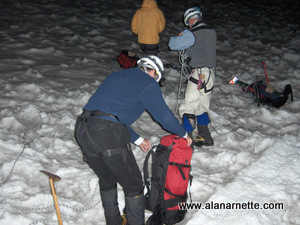
Once JJ announced time to "Rock and Roll", everyone got dressed
quickly, including putting on the avalanche beacons required
by RMI insurance. Helmets and harnesses were also provided at the
hut. The Rainier 9 was to be the first up the mountain so we gathered outside
the box to attach our crampons and rope up. The sky was perfectly
clear with little wind and a temperature around freezing.
I anchored the lead rope with JJ in front and two of my teammates
in between. We started a steady pace at 1:20 AM utilizing pressure
breathing and the rest step. This was to be routine for the next nine
hours. The route started as an easy traverse across the Cowlitz glacier
from camp Muir with little altitude gain. Once we hit the Cathedral
Rocks, we left snow and hit a mix of dirt, rock and boulders aka scree.
This was the first hint of things to come. The trail was well worn
through the Cathedral Gap as we made our way up about 300' to the Ingraham
Glacier.
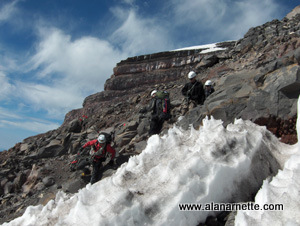
It was dark so we could not appreciate the views in front
of us but we knew we were climbing higher as we approached the first
rest stop at Ingraham Flats this after a 1000' gain and one hour of
climbing. As became the routine, we dropped our packs, put on our down
jackets, drank half a liter of water and ate a Cliff Bar or other snack.
Each break only took about 10 to 15 minutes, maximum.
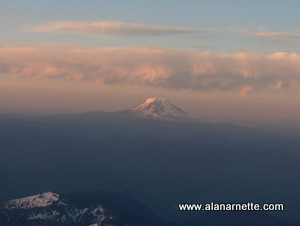
Back on the route, we approach the "crux" of our climb: Disappointment
Cleaver. This is a 1,000' crumbly rock bulge that was safer
to ascend than the crevasse ridden Ingraham. We would see the difference
upon our return later that day. There is one section of the route
along the Cleaver that tracks underneath a rock wall thus the need
to stay focused on the trail and stay alert for falling rock. Even
with helmets, it would be serious if one of these large rocks released
on top of you!
Once pass the "Backboard" we made the steady climb up the
cleaver. It was mostly switchbacks at a steady rate. We continued
our 1,000' an hour pace until the next break on top of the Cleaver. The
sun was just starting rise in the east making the entire area softly
lit. At the break, there was a little talking as we ate and drank
and took in the views of Mt. Adams, Hood and St. Helens to the south. With
the crux behind us, JJ announced we were almost to the summit. However
we were at 12,300' with another 1,811 to go! It was about 4:15 AM.
Now focused on the final legs, we climbed up the Emmons Glacier
to our last break at "High Break" or 13,500'. With dawn complete,
we could easily see the route but not exactly where the summit was.
Some of our team began to feel the altitude but with good techniques
of rests steps and pressure breathing everyone maintained the pace.
And then we there! The summit crater. A nice rounded area with fifty
foot walls thus defining the crater. It was filed with snow but
not deep.
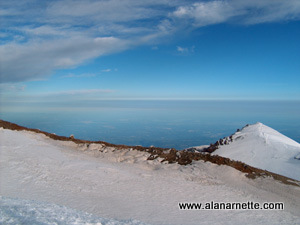
We waited for all of the Rainier 9 to arrive and continued
up to Columbia Crest, the true summit of Mt. Rainier. Even
though vocalists define a volcano's summit as the crater, mountaineers
claim the highest spot the summit so off we went. The views were
impressive: Washington and Oregon volcanoes to the south and to the north
the sub peaks of Point Success and Liberty Cap with the infamous liberty
ridge just out of sight. After a few pictures and a summit
video, we returned to sign the log book which was nestled
in some rocks near the west side of the crater.
After an hour, we left for camp Muir. We all felt pretty good
but a little tired but would, have felt better if we had known we had
made it from camp Muir to the summit on 5 hours and 20 minutes which
was a season speed record for an RMI team in 2004.
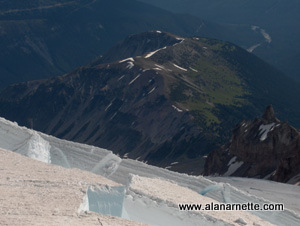 The
downclimbs to the Cleaver were steep. As I have always maintained it
is much easier to go up than down - especially with bad knees! But
we pushed on through the Cleaver with no real surprises until we approached
the Backboard -that area where rocks fall of top of your head! Now
the real dangers of Rainier revealed themselves: deep long crevasses,
sharp rock walls and ice cliffs - even in July. We made our way down
to the Ingraham Glacier where we took our final break and reflected
on our climb with our Guides. The
downclimbs to the Cleaver were steep. As I have always maintained it
is much easier to go up than down - especially with bad knees! But
we pushed on through the Cleaver with no real surprises until we approached
the Backboard -that area where rocks fall of top of your head! Now
the real dangers of Rainier revealed themselves: deep long crevasses,
sharp rock walls and ice cliffs - even in July. We made our way down
to the Ingraham Glacier where we took our final break and reflected
on our climb with our Guides.
Finally back to camp Muir. The return trip had taken 3 hours
and 11 minutes. We took on some more water, repacked our sleeping bags
and other gear for the final leg to Paradise. The guides and Canadians
boot skied all the way down but us slow folks took about two and half
hours. Once there, we took the bus back to RMI headquarters for a cold
beer.
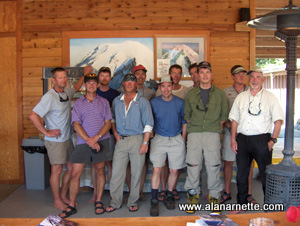
Rainier was a great climb for me. It was good
to be back on steep snow slopes in crampons with
my ice axe. The Rainier
9 was an excellent team that made the trip even more fun. And our
guides did a first rate job of getting us to the top ... and
back down safely and enjoyably.
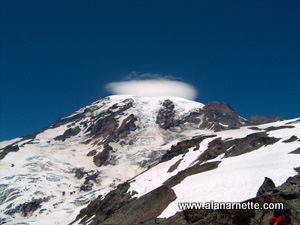
Mt. Rainier be "only" 14,111 feet high but it is a world-class
mountain in every aspect. It has difficulty, mixed terrain, weather
and, like all other mountains, is unforgiving to mistakes. We were
fortunate to have almost perfect conditions. As we were trekking out,
a lenticular cloud formed on the summit. It was almost like she was
saying "You got me this time, but watch out next!"
Click here for videos of the climb.
|

